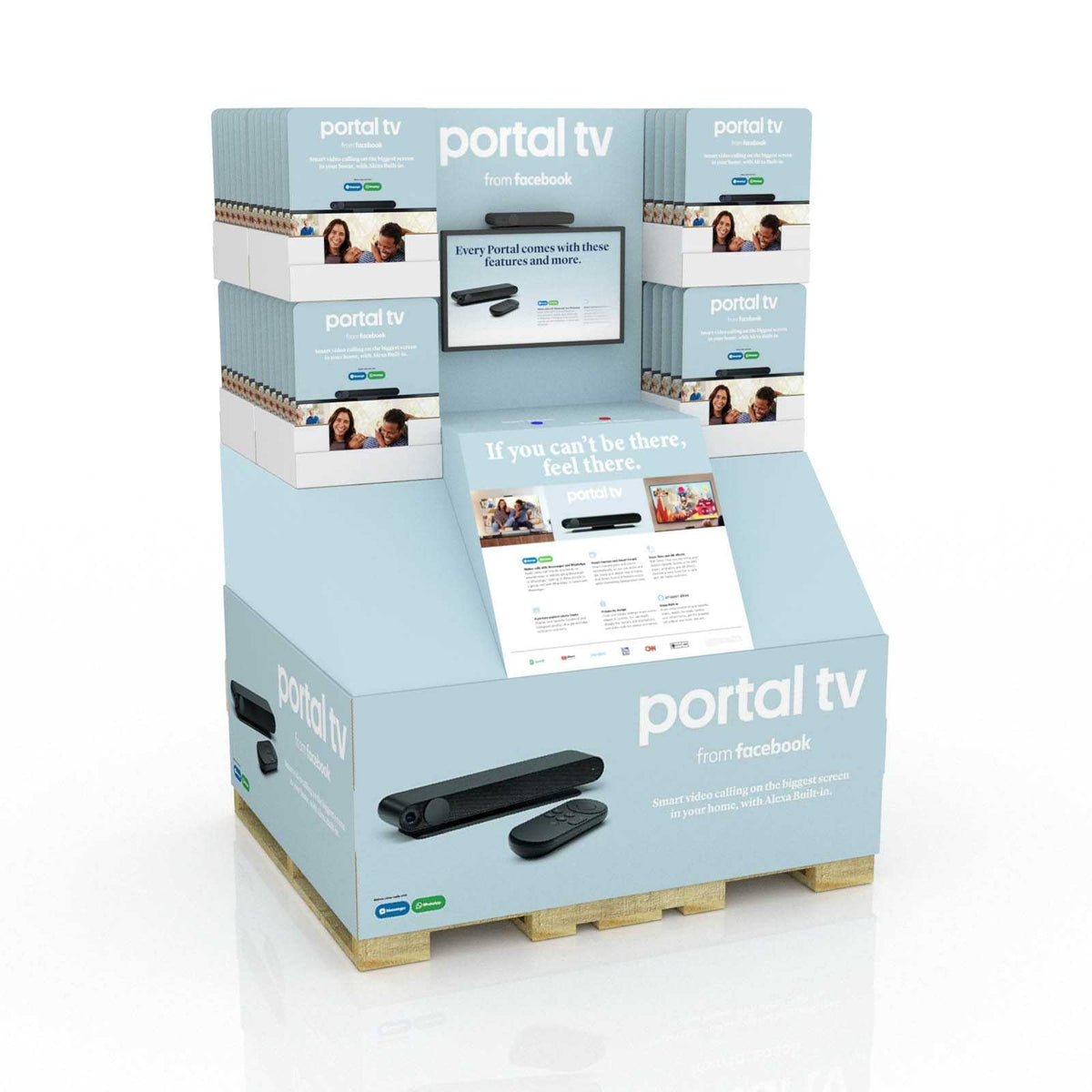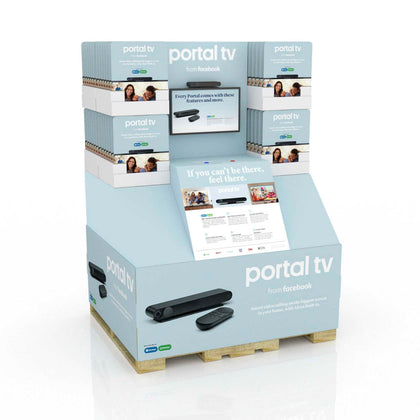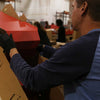

Any place in the store where a customer interacts with products that aren’t at the checkout is a point of purchase or POP. POP Displays are displays distinct from the usual shelves in the aisle. They can effectively place a product in the path of a consumer as they go through the store.
Including POP Displays in your plan allows for memorable interactions between customers and your items. Without them, your products might go unnoticed. Their entire goal is to allow your product to stand out from the crowd.
POP displays are a great way for retailers to stand out from the competition. They allow customers not only to see what's on offer but also engage with them by giving discounts and deals at their leisure, making it easier than ever before, so people can shop without stress or worry about running low.
In this blog, we'll cover some basics about POP Displays and give tips on implementing one into your strategy.
Table Of Contents
What Is a Point of Purchase Display?
POP displays are typically found in the middle of a store's aisles, or at the end of each aisle. These displays provide better exposure and branding opportunities for your products because they create a store-within-a-store. Usually they include product benefits, a brand story, and bright colors to attract customers.
There are several benefits to employing POP displays.
First, they get your goods off the shelf and highlight them to prevent "analysis paralysis." That feeling that a customer receives when their options are too many.
Next, using POP displays increases the chances of a customer selecting your product over a competitor.
They're also more adaptable than a typical retail shelf, so they may be tailored to suit any marketing campaign, season, or holiday event. Brands can build them to match any campaign, season, or holiday.
Is There A Difference Between POP and POS?
The "point of purchase" acronym sometimes refers to POP and POS displays. That's because they are used to draw more attention to your company. The key difference lies in their visibility: POP displays are spread across the store, whereas POS displays are usually positioned closer to the register, where the actual product transaction occurs.
Guidelines for Implementing POP Displays
Before we start, there are a few things to remember regarding POP displays. When creating strategies for POP displays in your retail execution plan, work through the following four steps.
1. Determine Your Goals
The first thing to consider is, “what am I trying to communicate with this display?” Is this display going to be used for a single marketing campaign? Or does it need to be used for an entire quarter?
For example, if you're planning a "buy one, get one" deal or a product bundle promotion, the goal of the display should be to entice consumers. Or if it will be up during the winter, creating graphics that fit during the snowy months is a good idea.
You can also include custom signage around the display to draw customers in. Once you have determined your goals for this POP Display, you can move to step two.
2. Target Your Customers
The next question to consider is your target customers. This answer is determined by a number of criteria, including the type of store the display is being placed in, where it is positioned within the shop and your target demographic.
If you haven't already, consider creating a customer profile. Make a list of the things that your target customer loves—everything from the color choices, down to specific design elements.
If your POP display is in a convenience store rather than a grocery, the buyer and the reason for their visit will be different.
A customer in a supermarket searching for a large number of items is more likely to come across your product browsing the shelves. Whereas a convenience store customer typically only seeks one or two items. Thus, the likelihood of product discovery is less.
3. Location Of The Display
Third, where is this display best suited? There are so many types of displays, each with their own purpose. You may want to take over a shelf or an endcap and create a store-within-a-store. Or perhaps you want a large full-pallet display.
Different retailers have distinct strategies to consider. For convenience stores, placing your POP display near the entrance is optimal, given that convenience store shoppers tend to focus less on the entire shop compared to grocery store shoppers.
Another point to consider is that if the store where your display will be installed has a limited amount of room, you don't want to utilize a big display that would block the aisle.
If you're selling a small product in a big store, it's also possible that your goods will be overlooked if you choose a tiny stand.
4. Find A Supplier
Finally, you must decide where to get your POP display. While there are numerous internet merchants from which to select, not all of them are created equal.
Take the time to ask your dealer for references, and be sure to read what other customers say about their experiences with each supplier.
Once you have these details and goals in mind, you should take a look at the types of POP displays offered.
You might want a standard display or have them made to order with any customizations to fit your product or retailer.
There are also firms that focus on cardboard displays, whereas others specialize in longer-term displays made of wood or metal. Make an informed choice by examining your various alternatives carefully.
Examples Of POP Displays
Let's look at some examples now that you've determined your objectives, a retail provider, and a display style.
Banner Stands
The term "banner stand" refers to standalone signage that businesses may use in their stores to promote their goods or announce a deal.
Banner stands are a cost-effective, mobile solution for attracting customers' attention. Always keep in mind that less is more when constructing a banner stand; you don't want to overload the consumer with color or text.
If your banner stand isn't next to your product, include a note within the design showing where it may be found in the store.
Dump Bins
Dump Bins are enormous containers in stores that are frequently filled with individually bagged items. They're often crammed with sweets and other tiny goods that appeal to impulse purchases.
These displays are a fantastic way to get your brand noticed, particularly since they are standalone displays that may be seen or interacted with from all angles.
Dump bins are also frequently produced of cardboard or can be readily customized, making them an excellent way to express your brand's image in a creative manner while still being simple for your field team or distributor to transport and put up.
Endcap Displays
Endcaps are displays that are located at the end of a row where two back-to-back aisle shelves exist. Endcaps, like free-standing displays, allow you to display your goods in strategic locations without requiring aisle shelf space.
They also provide you with a great opportunity to catch a large number of people's attention - shoppers can view your exhibit without even walking down the aisle.
Floor Display or Floorstand
A floor display, also known as a floorstand,is a type of POP display that is usually freestanding. It can be made from various materials, such as metal, plastic, or wood. They are designed to hold and present products to customers.
Floor displays can come in all shapes and sizes- they are often used to showcase products that are too large or too heavy to be displayed on traditional shelves or racks. They are also a great way to attract attention to products that are located at the back of the store.
Freestanding Display
Freestanding displays, like as dump bins, are standalone displays that may be interacted with from all angles.
However, they are more ordered in appearance than Dump Bins, and when larger items are displayed on shelves or hooks, they do so rather neatly.
Freestanding displays, like dump bins, are often constructed of cardboard, so they're a fantastic place to try out some eye-catching forms or designs.
Pallet Skirt
A pallet skirt is a type of POP display that is used to cover or hide the bottom half of a Pallet Display.
These have four large panels to include branding elements, high resolution imagery, and product benefits to educate customers.
One of the cheaper solutions to enhance a simple looking display, they are best designed in tandem with your products.
Full-Pallet Display
A full-pallet display is a type of POP display that is made from corrugated cardboard. They stand independently and are designed to showcase and present products to customers.
These have one of the largest footprints at retail stores and are reserved for a more premium look. While there are cheaper versions of this display, they're best used when you want your product to look like the top-tier option.
Half-Pallet Display
Just like the name says, half the footprint of the full-pallet, these displays bring the cost down while maintaining a premium feel.
They're a great choice for those wanting the buyer's attention with an attractive display. Whether you're using it to list items on sale or show off new products at retail, they're a great choice.
Quarter-Pallet Display
These have one of the smallest footprints at retail stores and are reserved for more budget-friendly situations.
They still give you a small pallet skirt to include more branding information. They have limited room for products, so they are for more strategic usage. If you're looking to put specialty items on the floor, this is the display for you.
PDQ Tray or Counter Display
PDQ Tray or Counter Displays, are standalone displays that may be interacted with from all angles. However, they're usually much smaller than Floor Displays and Dump Bins in both size and weight.
These displays are usually near the checkout aisle and full of low-price, light-weight products.
They typically have a top portion attached to the bottom for holding products. But you can find them in many different shapes and forms out there.
Shelf Display
A shelf display is a POP Display that can have many different styles of construction, but are shelves. They can be stacked to create a miniature "pallet" display or as a standalone shelf.
These are the most common because they have a smaller footprint. That makes them great for use in narrow aisles, particularly in grocery stores. They can also be used at eye-level for attractive displays with high-resolution imagery and branding elements.
Use these displays when you must still be on a shelf, or need to stack products together, but still want a nice presentation.
Sidekick or Power Wing
Sidekick or Power Wings, like some of the others, are standalone displays that may be interacted with from all angles.
However, similar to Floor Displays and Dump Bins, they're larger than PDQ Tray or Counter Displays in both size and weight. They're often used in high-traffic areas where a product is desired within arms reach of the end user.
They can be freestanding or mounted on a shelf for maximum impact when customers walk by them in a store aisle. Use these for your most popular items!
Specialty Signage
This is anything from a corrugated standee, to a hanging display that draws customers to certain areas of the store. It is a broad category of displays, focused on the unique custom styles.
However, these are typically not for products but instead, offer some sort of promotion or deal instead. They can be freestanding billboards, hanging signs, point-of-purchase (POP), or POP display posters like, banner stands or floor-standing posters.
Use these displays when YOU want to be the distraction in the aisle!
Order A Point Of Purchase Display From Bennett!
As you can see from the above list, there are many different types of POP displays that you can find at any store. One thing we didn't get into was choosing between a stock and custom display, but since we make them... We prefer the custom ones!
You'll even find them in small shops on the side of the road selling their merchandise. The main thing to remember is that all these displays play a huge role in drawing attention to your product!
Which one do you like best? Do you have any stories about how one of these products helped drive sales for you? Leave it in the comments below!




